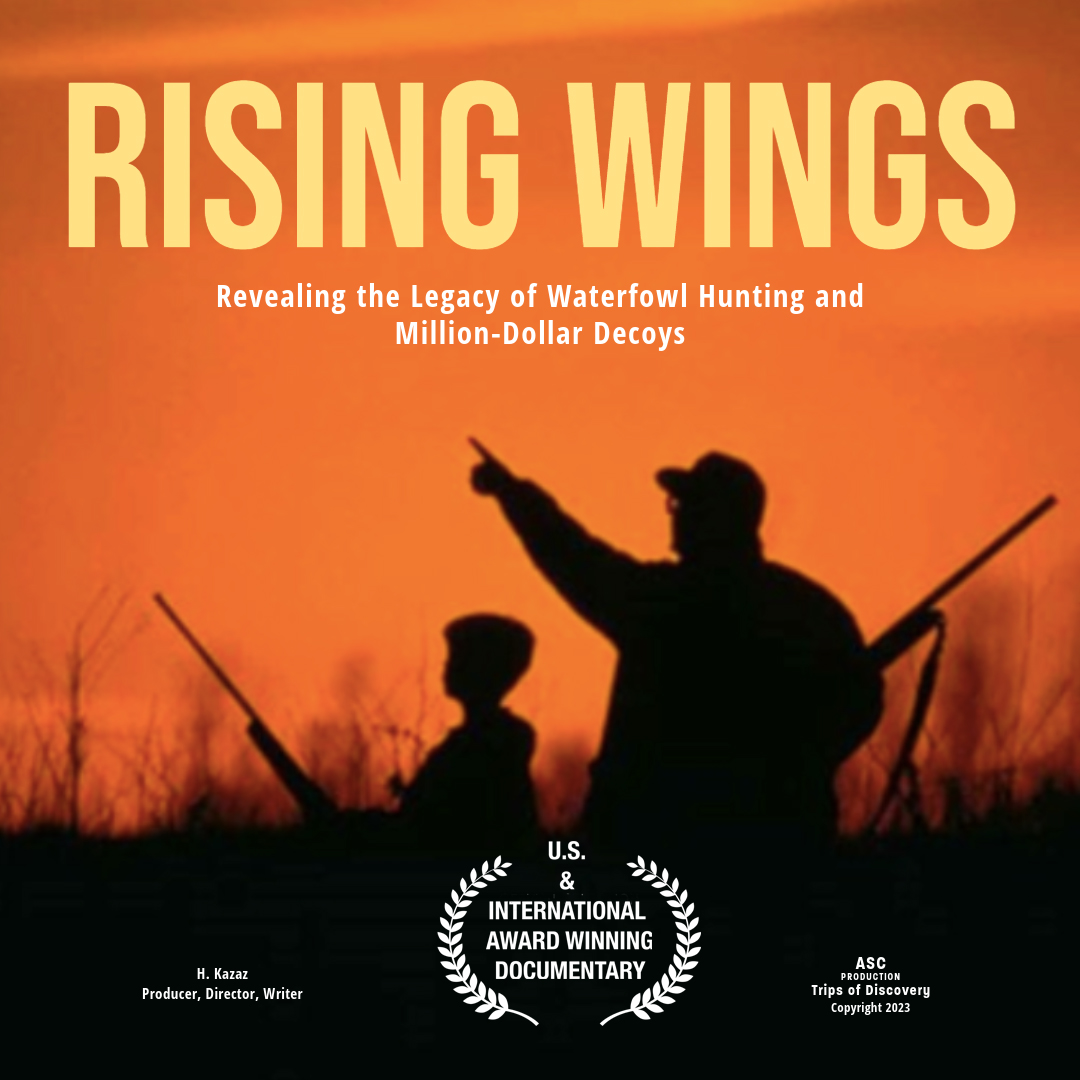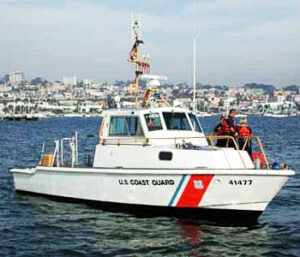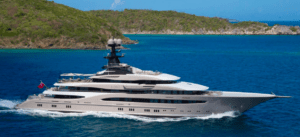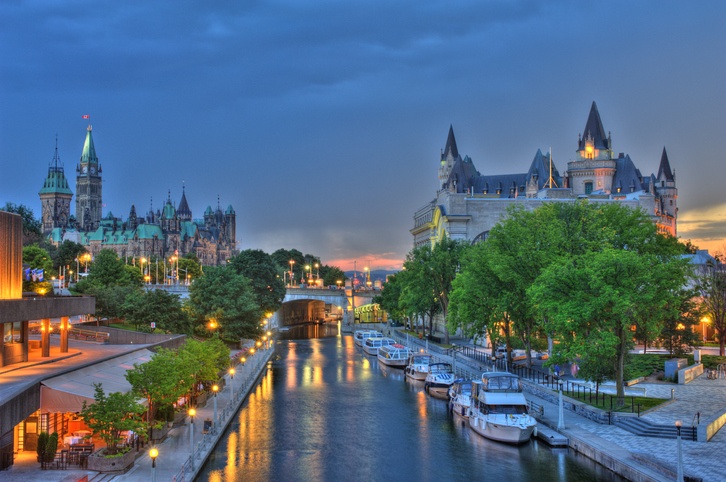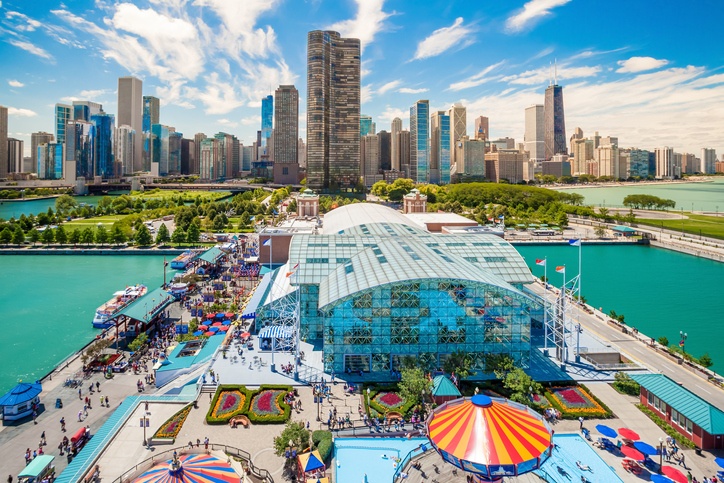6 tips for the Atlantic ICW journey and the story of Makau
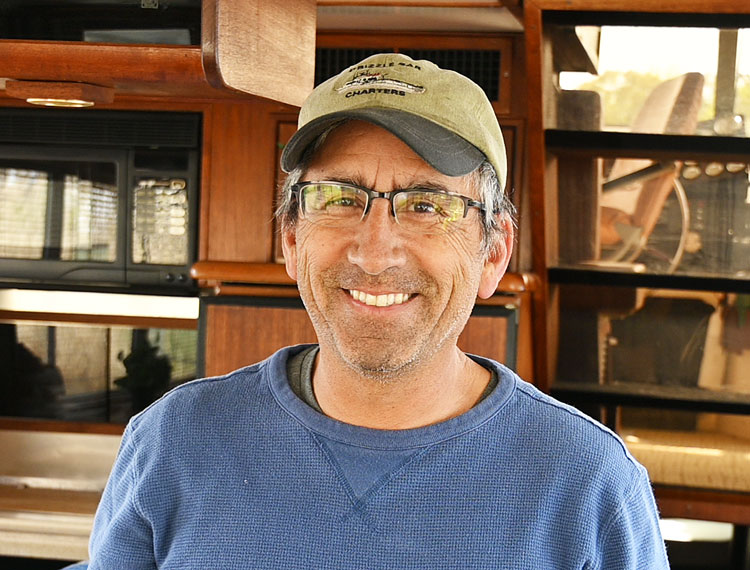
Estimated reading time 18 minutes – We recently had a great time talking to Captain George Bentz and his wife, First Mate Lisa Bentz, about the lessons learned from their semi-prepared cruise up the Atlantic Intracoastal Waterway (ICW) from Port Charlotte, Florida, to their homeport in the Chesapeake Bay this past spring. By the way, they definitely don’t suggest anybody do it the way they did it, “semi-prepared” being the operative word. The 6 tips they shared with TripsOfDiscovery.com readers and anyone contemplating a future trip on the ICW was most compelling.
Excellent communication with your crew at all times is a must
Let’s start with Tip Number 1: Excellent communication with your crew at all times is a must. Captain Bentz stressed that the best practice is to apologize for what you are about to say before docking. Yes, not adhering to this best practices advice during your cruising, especially on long-haul ones like the ICW trip, will get you in trouble in more ways than one. If that happens, you may find yourself murmuring something like, “I threw a boomerang a few days ago. I now live in constant fear.” Just remember, an Atlantic ICW trip is more than 1,200 miles one way, with many many days on the water, and you will have many live docking exercises on your way before you reach your destination.
It’s hard not to take any tip from Captain George Bentz to heart when it comes to boating, let alone for an ICW journey. Take his first tip above seriously, very seriously. If you are a man, you do not want your friends to think of you with a phrase something like, “Behind every man is a woman resisting the urge to choke him,” during those sometimes awkward docking experiences that we may live through in tight marinas. You know, that darn odd slip that you have to back into without accidentally hitting the boats on both sides on the first try. Also pray that someone, any one, would come over and help you from on the land to help you to dock rather than watching your struggle like a great adventure movie. Let me stop here—if you don’t know what I’m talking about and if you’re going to do destination cruising, you’ll soon know what I’m talking about. Just remember Tip Number 1 in this post. Trust me, you’ll feel better after you complete your docking, be it backing in or pulling up in any way, shape, or form. I asked George if he had to worry about his marriage. He said, “ Nope. Nope. We had a blast. It’s what we wanted to do. So it wasn’t something that I wanted to do when my wife didn’t want to do or something she wanted to do and I didn’t want to do.”
Captain Bentz has more than 25 years of boating experience under his belt, holding a U.S. Coast Guard 100 Ton Master’s license, topped with running a successful charter boat business for years, in good as well as not-so-good weather. That makes him uniquely qualified to give tips that we all need to take due notice of. He is the type of person who has grown up on the water. He did not say it, but if you ask his age you could easily expect him to say something like, “I love my age. Old enough to know better. Young enough not to care. Experienced enough to do it right.” Then you would see him in a great pirate costume and persona, having fun with others on a pirate weekend in August. Again, he did not say it but he might as well say something like, “Do not take life seriously. You will never get out of it alive,” and break out his contagious laugh.
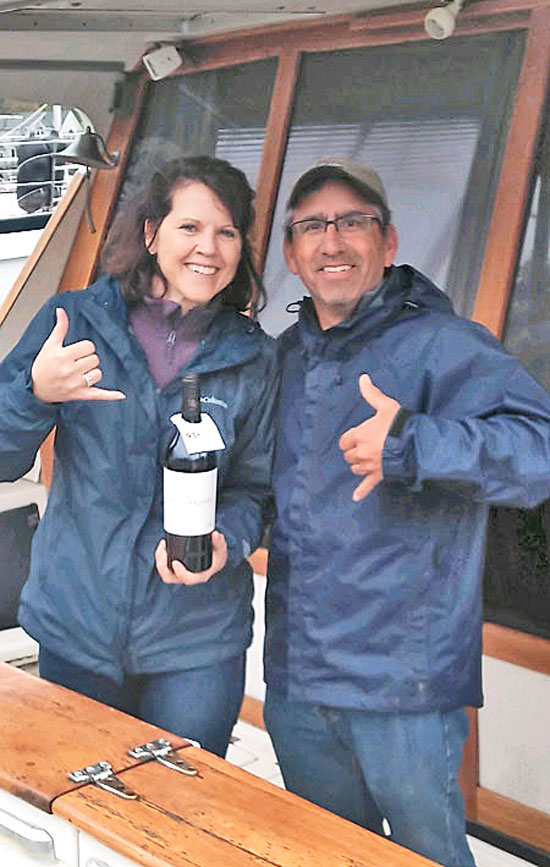
Who is the First Mate of Makau, the woman behind the successful Captain Bentz? It is Lisa Bentz. Just like George, she grew up on the water. She grew up on the Chesapeake Bay, sailing Hobie Cats, paddling rowboats, and enjoying jet boats from elementary school onward. While George was the pilot, she was the navigator during their kind-of, sort-of semi-planned ICW trip. Responding to my earlier question about the stress of long-distance cruising and if George worried about his marriage, Lisa said, “You know, since we were so excited to be doing this adventure, we never really argued much.
“There was one day though when things didn’t seem to go right all day starting with our tablet, on which we run Aqua Maps, not being charged.” They were careful to recharge their devices religiously, every time they docked at marinas, but for some reason that day they didn’t charge overnight. She said, “We realized the problem a few miles from the infamous ‘Rock Pile’ where we were definitely going to need it. George asked me to take the wheel while he started the generator (for the first time) so we could charge the tablet. As I was piloting, I noticed the steering not being very responsive. I quickly set that aside though when George came hollering up to the helm shouting that the cabin was filling up with smoke.
“Deep breath….he shut down the generator, let the smoke clear, and then we focused on the odd steering.” Well, it turns out that they were quickly losing all steering and that’s when the “controlled arguing” began. Lisa continued, “We were only about a mile or two from the Rock Pile. Fortunately, I found a close marina that allowed us to tie up and they even charged our tablet up for us. George was able to fix the steering and we went on our way, making it through the Rock Pile with no problem. That was our most trying of days, but in retrospect, we got through it because we’ve always had a balance in our marriage where when one of us is breaking down and losing it, the other immediately kicks in, steps up, and carries the other through. We’ve both played either side of this at various times throughout our 30 plus years.”
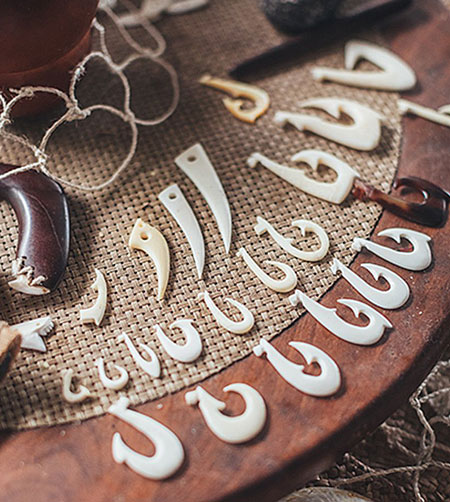
Then comes the Makau. The word has a cultural meaning that very much relates to George, who’s family is from Hawaii. Makau is regarded as a symbol for safe passage over water and has held deep cultural significance in Hawai’i and throughout the Polynesian Triangle for over a millennium. The Makau, or the Fish Hook, represents strength, prosperity, abundance, and great respect for the sea. Traditionally carved from bone, wood, stone, and coral, different makau were crafted to catch every single type of fish and sea creature; a craft which was often passed down through generations. Over the years, makau became something more than a common fish hook. They became prized possessions that were thought to have a spiritual life force. The makau became a part of Hawaiian lore when the god Maui used one called Mānaiakalani to hook the islands together in an effort to unite them. Today, the makau is “a symbol of humans’ connection with the sea, its creatures, and the fragile balance of life on the Islands.”
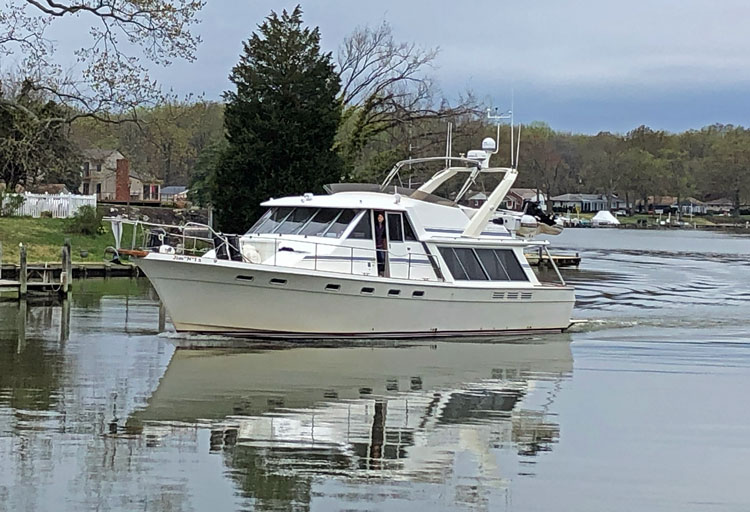
Now the word Makau has also an additional meaning for the Bentzs. It is the name they gave their newly purchased 45’ boat. George and, in a limited fashion, Lisa had been scanning the market for over a year to locate the right boat with the right layout for their cruising pleasure. The couple had a very specific requirement for a boat that perhaps one day they may use to embark on America’s Great Loop journey. What were they looking for? George said, “First of all, we checked out the overall height and draft restrictions because we plan to do the Great Loop one day. Then we wanted to have an open layout where the galley and salon were on the same level. We needed to have safe, easy access all the way around the outside of the boat.” George especially wanted to have an exterior piloting/driving station as well as inside, in case of poor weather. He also looked for a design that does not have a ladder requiring one to climb to get to the bridge. George said, “Finally, we wanted to have an easy entry from the swim platform into the cabin, such as an entry at or near the same level as the dock, rather than having to climb up a ladder to enter.” Not many boats in their price range offered all of the items on their list. Finally, they focused on Bayliner, a brand and type of boat that is popular among America’s Great Loop travelers. George said, “When we settled on the Bayliner, we initially looked at the 4788. Eventually, we found that the 4588 was plenty spacious, had the same layout, albeit with a smaller salon, and would help save on maintenance and marina costs being a few feet shorter.” Then they found their boat, now renamed as Makau, in Port Charlotte, Florida, and welcomed her into their life. It is now their home away from home on the water.
Be prepared. Be prepared.
As all boat owners know, the cardinal rule of boat ownership is to know as much as possible about your boat. If something goes wrong in the middle of the water, you have to have an idea of what is going on, even if you are expecting a towboat. Sometimes you may not have that option at all. The larger the boat, the more for you to learn.
As soon as they found a suitable boat for themselves, the Bentzs needed to go from their homeport in Maryland to Port Charlotte, Florida, to bring it home. Moreover, they had a limited timeframe in which to make the trip. Relying on their extensive boating experience, with minimal preparation and some ‘must have’ gear for the maiden voyage of Makau, they set forth.
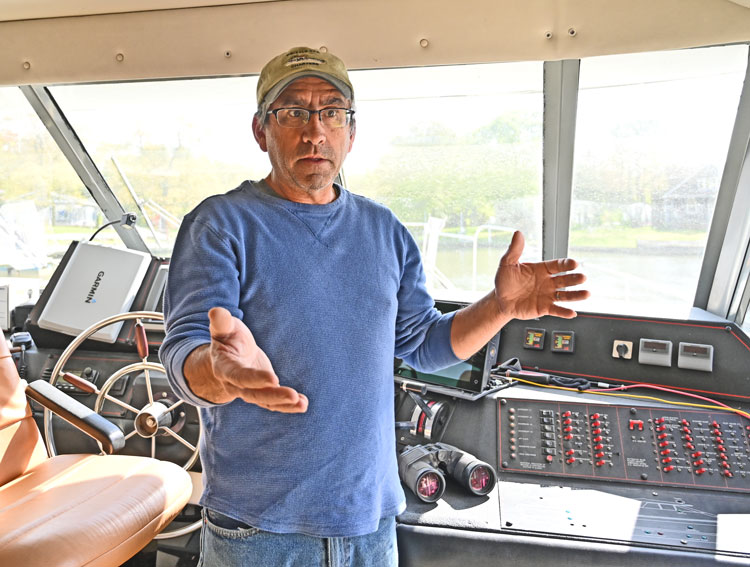
For all of George’s solid experience, still, this was the first time he was piloting this particular boat. He knew very little about the ins and outs of the boat. He said, “I did not know all the systems on the boat. I just didn’t know because it was new. So that was a tough one to get used to. I mean, we got on the boat and just went.” I said, “It’s not like renting a car, is it?” George said, “That is correct. The first marina we went to, I’d never plugged a boat into a station or anything. I didn’t know if I could’ve make this work. So we did figure that out. I mean, it sounds funny now. I have 50 amps on there. So, luckily enough, I noticed that they had it tied to a single 30 amps and we didn’t need any more power than that. When we pulled into a marina or whatever, really all I needed was a battery charger and a refrigerator. We pretty much just opened up the windows for the night. We had a couple of times where we had to kick the heat on, one night we had to turn the air conditioner on because of bugs. There were tons of bugs. Bugs were there at night time. By morning they were all gone.”
I don’t suggest anybody do what we did, really.
George said, “I don’t suggest anybody do what we did, really. No, no, not at all. Be prepared. Be prepared.” He continued, “I guess, because I’ve run the boat all the time, there were certain things that I needed. Types of things that I had to have on that boat before I would move. I know that it sounds like we just jumped on it and left, but I went down, I changed the batteries. I wanted brand new batteries to get home. Batteries run your equipment, you rely on that. I need good batteries. I’m not playing around. I changed all of that stuff. I wished I had the time to change the filters because it was in a boat that I’m not familiar with.” Captain Bentz continued, “If you ever go on a trip like that, I would’ve changed the fuel filters and done an oil change. Didn’t have time for that. I just scored a boat and ran. However, anything can happen on the water. Like we could have gone a mile offshore and then the filters could have clogged. I mean, it could’ve happened, but thank God it didn’t. Don’t do what I did. But, I was prepared, I knew where the filters were. I knew what to do if we ran into that situation. So there was a level of preparedness going into this trip. So we did just jump on the boat and we did just leave, but with a level of confidence that we weren’t going to have a problem.” Because they were going to have a trip with a boat that they weren’t familiar with, the Bentzs looked at some reference materials and watched some YouTube videos relating to the boat, but that was it.
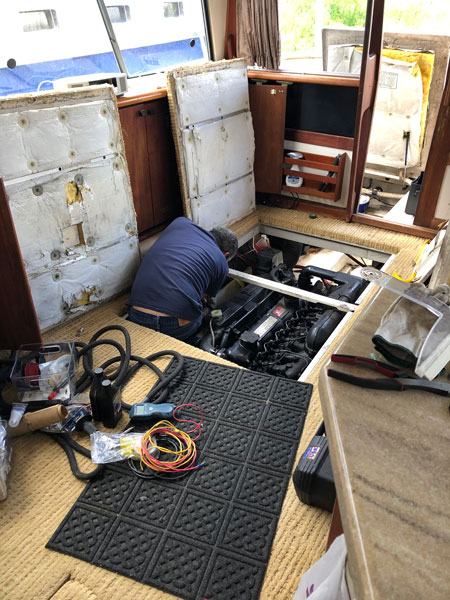
You must have paper charts on board
Far in advance, Captain Bentz studied the maps between Port Charlotte, Florida, and Maryland. He familiarized himself with where the bridges and challenging spots are. He said, “If you are a cruiser, don’t overlook the value of paper charts. You may have multiple GPS and all kinds of electronics equipment, but none of them are a substitute for good paper charts.” Well, did he have them? Nope. He knew it and he wished he had it. He said, “The one thing I wish I had on board, which I did not, were paper charts. Yeah. I like my paper. So when I got down there, I expected to find some charts on the boat and I found some, but they weren’t everything that I needed. So went to a West Marine and they had only one, Florida. I needed more than just Florida.”
If you take some advanced boating courses, they will tell you that you need to have paper charts at all times.
If you take some advanced boating courses, they will tell you that you need to have paper charts at all times. George elaborated why one would need paper charts along with GPS units. He explained that he did have 3 GPS units on board and they also had apps on their phones and on their tablet. They did get home safely, of course, but the value of the paper charts would be for events like when you read the reference books and sometimes they don’t make sense. Paper charts also help you to see the big picture and help you along. Sometimes you may need to find your way without a GPS unit. GPS signals can go off or simply go wild. Also, although they are a truly rare event, stories are circulating that intentional GPS jamming events have been taking place. Apparently, they have been increasing both in numbers and in areas affected by the staging of military training exercises as well as foreign adversaries selectively jamming GPS signals or misdirecting them. Also, let’s not forget the Sun’s plasma projections that can and do affect electrical events on earth without warning, in which GPS signals can be affected as well. So low-tech devices like paper charts become critical.
First Mate Lisa Bentz was the navigator during the whole trip. She said, “I learned a ton while navigating the boat on this trip. The Waterway Guides were a great resource for learning about areas we’d be coming into, what to watch out for, what marinas offered different amenities, etc.” But she too missed large paper charts. She said, “Sometimes I read this information on the guide, then it just doesn’t make any sense. But if you would have opened up a paper chart, it made perfect sense. You know how they’re talking about certain markers and so on. It is not the same looking at them on a small screen.”

Lisa earned her boater’s license when their son wanted to get his, 15 years ago, but hadn’t really put it much into practice. With George’s instruction, she was completely comfortable piloting the boat, even though extremely thick fog and having to rely on the radar. So, what does Lisa think about women piloting a boat in addition to navigating? She said, “I’ve never really given it much thought. I don’t think there’s anything special or more that a female pilot has to do to reach the same level as a man. She just needs to have the desire to learn and do it.” As for Lisa’s role, she thinks it will likely remain as the navigator and back up to the captain as a true First Mate. She said she enjoys planning out the routes and stops. However, her goal is to become comfortable with maneuvering and docking so that she’s able to take over in the event of any emergency.
George said, “I had a second GPS that was set up in the helm and I split the screen there. So I had two views of GPS running all the time that I could reference. And then the other one, at least I have that half of the screen, and Lisa could zoom in, zoom out, move all around, whatever she had to do to look and see where we’re heading. And what was it, what was ahead? So the paper charts would have been a lot better.”
Plan for provisions and fuel stops
Thankfully, the ICW is a mature waterway with numerous facilities on the way. However, Captain Bentz recommends that you do not take that fact for granted and plan for your provisions and fuel stops in advance. When you arrive at your planned destination, the first thing that you should do is fuel up before you do anything else. There’s a large volume of information resources out there to help you plan as well as navigate. (See the 6th tip below.) Know your boat’s range and plan your trip accordingly to stay within it. Know if the distance you plan on traveling will take you 5 minutes or 2 hours or 8 hours! Make sure you know how much fuel that will take, and make sure you leave an extra reserve for unforeseen contingencies.
Always monitor the weather and tides
Captain Bentz is the type of person that when he looks at the sky and checks out the wind on his boat, he thinks of how the weather may be turning and planning for his next step for the safety of his passengers, while someone else may be looking at the same sky and thinking how nice and breezy it is.
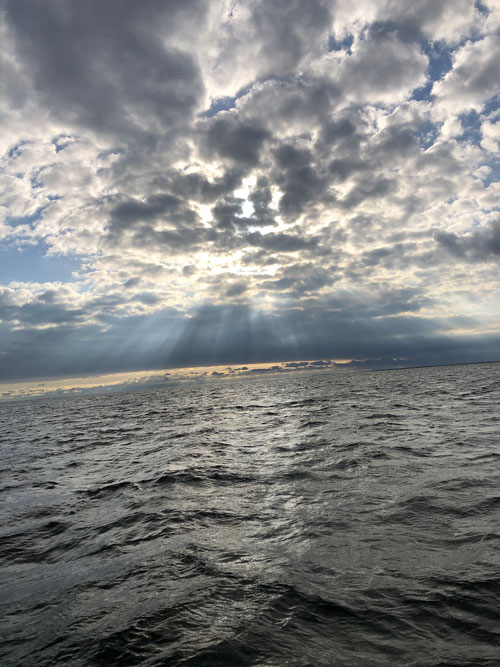
Always keep an eye on the sky. Fog, dark clouds and lightning are clear signs that bad weather is approaching. Check the weather conditions at all times. Monitor barometric readings. A rising barometer is a sign that good weather is coming while a falling barometer indicates that foul weather is likely. Tides affect the depth of the water and of the currents in and around coastal areas. As we all know, the fun of pleasure boating is only possible when it is done safely. Weather conditions and tides are two of the major natural elements in boating that all boaters must take due notice of and consider no matter where they are at.
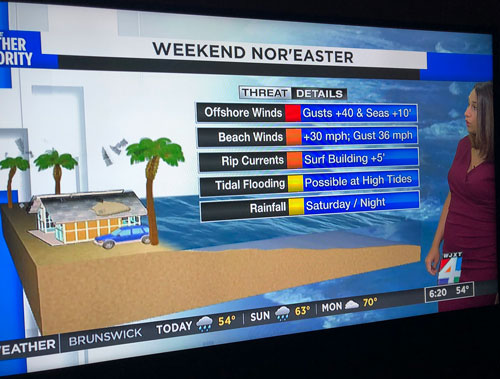
Have the latest version of the Waterway Guides with you as well as boating apps
As I mentioned before, there are rich and detailed information resources in the market to help you to achieve a fun, successful, and safe ICW trip. Captain George Bentz and the First Mate and navigator Lisa Bentz’s favorite resource is the Waterway Guide. However, he points out, correctly, that if you are planning to start an ICW journey soon, you should have the latest version. Marina establishments and a whole host of other critical information often change over time. You do not want to plan for something that may be referred to in an old version of the guide that may have changed already and surprise you while you are underway. Events like that may take all your options away and place you in a difficult spot and take all the fun out of your journey.
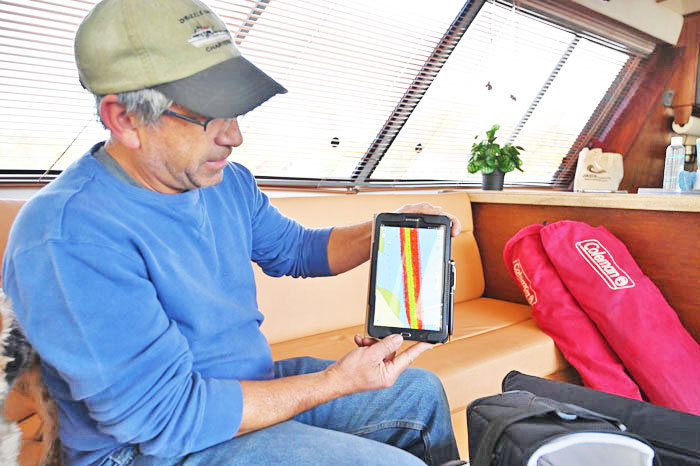
These days all boaters, in addition to their chart plotters, have at least one if not more applications on their cell phones and tablets. So, when it comes to boating software, there is also a large amount of software out there, from charting to wind and weather forecasts to creating automatic boat logs to serve every possible need that you can think of. In the case of charting software, Captain Bentz used and recommended the Aqua Map application. In addition, Lisa Bentz used two marina finder applications for planning, Dockwa and Snag-a-Slip. She was responsible for obtaining their slips each day once they figured out how far they could travel and where the marinas were located.
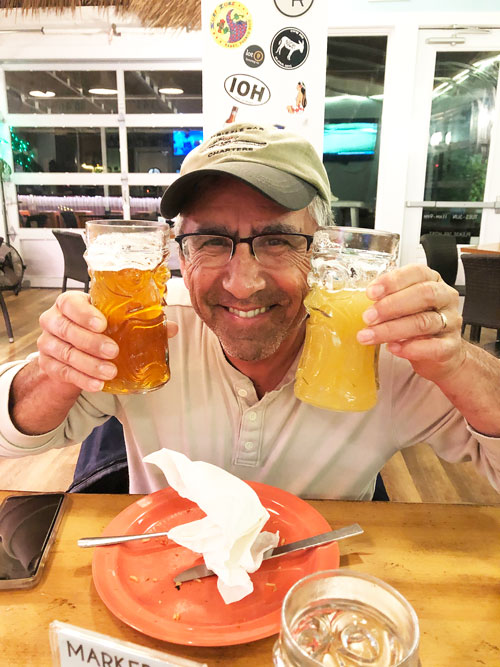
Well, that’s it for now. Stay well. I hope to say hello to you if you spot my boat, Life’s AOK, in one of the locations that I’m hoping to visit in 2021, that is if Coronavirus permits us.
I bid you Fair Winds and Following Seas.
2 things I learned
- The part of the Intracoastal Waterway referred to here is the toll-free “canal” that affords continuous protected passage behind the Atlantic Coast and the Florida Keys for more than 1,243 statute miles between Norfolk, VA, and Key West, FL. In the case of George and Lisa Bentz, they picked up Makau, a 45’ Bayliner, from Port Charlotte, Florida, located on the Gulf of Mexico side of the ICW. They crossed Florida using the Okeechobee Waterway, which junctions with the Intracoastal Waterway in the St. Lucie Inlet. Then they continued up north into the Chesapeake Bay to their home port in Maryland. Because of their tight work schedule, they completed their trip in 18 days.
- The “Rock Pile” that Lisa was referring to above is a man-made canal-like section of the Atlantic Intracoastal Waterway, officially known as the Pine Island Cut, running between Little River and Waccamaw River. The canal is narrow and lined with submerged rocks and a rock shelf, just a foot or two below the water’s surface.
2 things I recommend
- If doing an ICW trip or America’s Great Loop journey appeals to you, just remember, if you do not have a dream, your dreams cannot become a reality.
- You may follow my Slow Boat to Florida (SBFL)* series to get an idea about the locations that you can stop by during an ICW journey.
How easy?

*SBFL stands for Slow Boat to Florida. It is a series of my blog posts, which started with a posting that had the same title. Each numbered heading has two parts. The first is “Planned,” and when we visit the planned location, a “Visited” label appears at the beginning, next to SBFL. The essence of this series is not to seek new lands and exotic cultures. Rather, it is to cover our journey of discovery (hence the title of our blog Trips Of Discovery) that has to do with seeing with a new eye the coastal locations of the Atlantic Intracoastal Waterway (ICW) where present-day America started to flourish. The SBFL series represents part travel, part current and historical anthropological highlights of selected locations and coastal life. We’re comparing then and now, based on observations made by Dorothea and Stuart E. Jones in their 1958 National Geographic article titled, “Slow Boat to Florida” and a 1973 book published by National Geographic, titled America’s Inland Waterway (ICW) by Allan C. Fisher, Jr. We also take a brief look at the history of the locations that I am writing about. Finally, we bundle it up with our observations during our actual visits to the locations and our interviews with local residents. Think of it as a modest time capsule of past and present. My wife and I hope that you, too, can visit the locations that we cover, whether with your boat or by car. However, if that is not in your bucket list to do, enjoy reading our plans and actual visits as armchair travelers anyway. Also, we would love to hear from you on any current or past insights about the locations that I am visiting. Drop me a note, will you?
